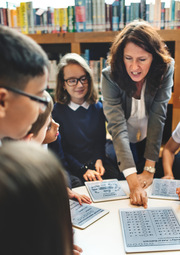Teaching Digital Citizenship: Integrating Social Media Safety in Middle School Curriculum
As the world continues to evolve into a more digital society, the idea of what it means to be a responsible digital citizen has come to the forefront. Many people agree that some of the same laws and societal norms that we use to regulate how we interact with one another in the material world should somehow be shaped to be applied to the digital landscape.
It is important to have a standard code of conduct for how we behave when we are online to ensure the safety of everyone participating in the digital world, whether it be for education, work, or social purposes.
But what does it mean to be a digital citizen, and when exactly should we introduce and teach its ideals?
What would a middle school curriculum look like that taught digital citizenship, cyber security, and social media safety?
Let’s take a closer look at what digital citizenship means as well as the many ways educators have been tackling this topic to better prepare students for online life.
What is Digital Citizenship?
Digital citizenship is the ability of individuals to recognize the rights, responsibilities, and opportunities of living in a digital world, while at the same time, acknowledging that the words they say, and the actions they take online, are recorded into a permanent record that will follow them for the rest of their lives. It is because of this permanence that children and adolescents need to be taught what it means to be a responsible digital citizen from an early age.
The Foundations of Good Digital Citizenship
In short, being a good digital citizen requires individuals to conduct themselves in the digital space in a way that is safe, legal, and ethical, while at the same time, operating within a basic level of morality. Although morality is somewhat subjective, there are still basic norms that people follow in the material world that should apply to the digital world.
The Consequences of Poor Digital Citizenship
Far too many times when we see instances of cyberbullying or online harassment, the perpetrator feels that because they are hiding behind a screen, they are free to act and say things that they may not do or say when in the real world and face-to-face with the victim. A large part of being a good digital citizen is understanding that there really is no difference between your online persona and who you are in the material world.
The Role of Parents and Educators in Promoting Digital Citizenship
So, although parents and educators can take steps to educate our youth and help them to become responsible digital citizens, what about other people? What about bad actors who may not adhere to responsible digital citizenship, and instead, use the digital world to victimize people?
By far, the largest space that our youth occupy in the digital world is social media. As an educator or parent, it is critical to understand that social media safety is a fundamental part of teaching digital citizenship. Many of the best private schools have recognized this and are leading the way by incorporating comprehensive digital citizenship programs into their curricula.
Adolescents and teenagers who use social media on a regular basis are at a higher risk of online threats such as cyberbullying, exposure to inappropriate content, and online predation. Not only that, but most younger internet users may also lack basic cybersecurity knowledge which can leave them more vulnerable to phishing, ransomware, and other more general cyber threats.
Integrating Digital Citizenship into Education
Fortunately, more school districts across the country are starting to add digital citizenship curriculum in middle school classrooms across the country. Middle school seems to be the ideal time in an adolescent’s life to prepare them for the digital landscape as this is the time in their life when internet use begins to increase greatly for everything from online classes and homework support to messaging peers and social media use.
So, now that educators have had some practice and experience implementing these new types of digital citizen curriculum into the classroom, what seems to be working and what are the most critical components to include?
Let’s take a closer look at what educators are finding to be some of the most critical components of a well-rounded digital citizenship curriculum.
Key Components of a Digital Citizenship Curriculum

In addition to some basic cybersecurity education, because teenagers spend a good amount of their time in the digital world using social media platforms, developing a well-rounded digital citizenship curriculum requires a strong focus on the risks associated with social media use to ensure social media safety for kids.
Also, keep in mind that when broaching the topics of cybersecurity and digital citizenship with younger learners, it is important to make sure you are finding and using engaging methods to teach these topics. There are a number of incredible resources available online to help educators and parents find materials to teach about cybersecurity and social media safety.
Here are some of the most critical components that should be included in a well-rounded digital citizenship curriculum.
Privacy and Security
Privacy and security are by far the most important topics to cover when discussing cybersecurity basics. The first thing that students should know is how to set their social media accounts private and the importance of disabling location sharing and the risks of geo-tagging photos. Online predators and scammers can use location data to stalk or learn more about the people they are targeting.
Another important aspect of privacy to discuss with students is the importance of not oversharing personal information on social media or to unsolicited messages. Information like addresses, legal names, online passwords, birthdays, social security numbers, and more, if posted online or sent in a message, can be used for a number of malicious purposes including identity theft.
When it comes to security, a basic overview of cybersecurity fundamentals is essential. Topics like how to avoid clicking on suspicious links or downloading harmful software, how to install and use antivirus programs, and what to do in the event of a cyber attack, are good places to start. The depth and technicality of the subjects you cover will depend on the age group, however, everyone should have a solid foundation of the basics of being safe online.
Identity Theft
Identity theft is a serious problem that many teens do not think about because they do not yet participate in the credit economy. However, students should have a basic understanding of how cybercriminals can use personal information that is shared online to open accounts in their name and destroy their credit or financial life before it even begins. Additionally, the advantage of a digital signature over an e-signature for signing important legal and financial documents is another basic understanding to have to help prevent identity theft and other types of fraud.
Relationships and Communication
Another focus of a digital citizenship curriculum should be relationships and communication. How we communicate online with one another is important to developing and maintaining relationships through digital communication. Assuring tone, inflection, and meaning are not misconstrued through email, texts, and other forms of digital communication will be an ongoing skill that students will work on and develop throughout their education and beyond.
Cyberbullying and Digital drama
It’s well known that Cyberbullying has become a serious problem that many schools are dealing with on a regular basis. It’s not only an abundant issue with more than 37% of young people between the ages of 12 and 17 reporting being bullied online, but the consequences can be destructive.
Young people who experience cyberbullying are at a much higher risk of self-harm and suicidal behaviors than those who don’t. Teaching students how to recognize cyberbullying and what to do if they experience or observe it is a fundamental part of an impactful digital citizenship curriculum in combination with strict zero-tolerance policies.
Digital Footprints and Reputation
Another key aspect of digital citizenship is understanding that everything posted online is permanent. Even if you delete messages or posts, there is still a digital record of all communications. Also, your digital footprint is directly correlated with your reputation. Anything you post online about yourself and what you are doing or anything you post about others including comments, pictures, and other forms of content, can resurface years later and harm your reputation.
All students should understand that their digital footprint can have consequences down the road that they could never have imagined, especially if they participate in cyberbullying and other forms of online harassment.
Creative Credit, Copyright, and Plagiarism
Creative credit, copyright, and plagiarism are topics that have come into focus in recent years, especially with the development of AI programs like ChatGPT. Students should understand the basics of why it is important to give creative credit to originators, what copyright is and how it works, as well as how plagiarism is fundamentally wrong, even as society is introducing the use of AI into more arenas.
Conclusion
As more and more young people are getting online at earlier ages, many would argue that from as early as kindergarten, we should at least be introduced to some ideas of digital citizenship. Then, once students start reaching the age of middle school and they are preparing to be more active online, schools should introduce curricula to help students navigate the digital world in a way that is safe and constructive.
About the Author:
Ryan Harris is a copywriter focused on eLearning and the digital transitions going on in the education realm. Before turning to writing full time, Ryan worked for five years as a teacher in Tulsa and then spent six years overseeing product development at many successful Edtech companies, including 2U, EPAM, and NovoEd.





 Explore the Safe Search Engine -
Explore the Safe Search Engine - 